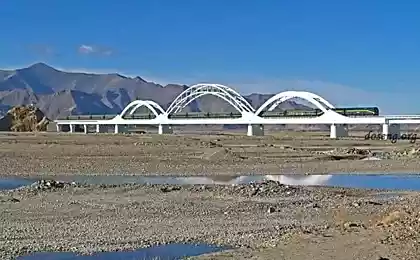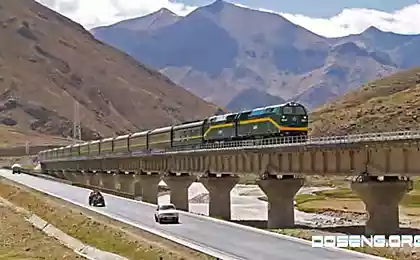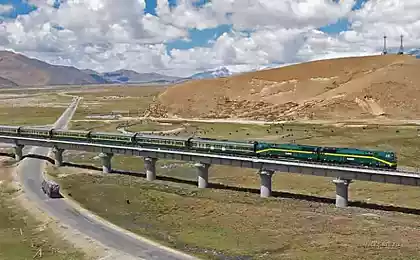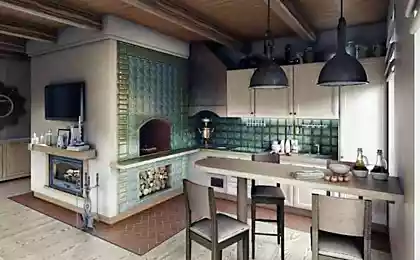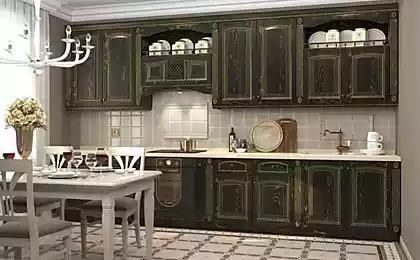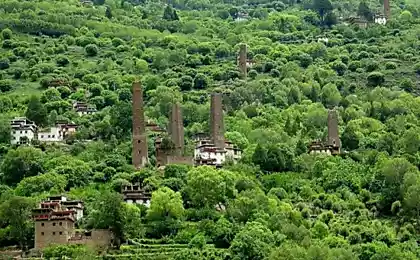846
Tibet Highland Kitchen
Himalayas. Tibet. Something cosmic and ethereal sounds already in the titles. They attract travelers from around the world. Before the magical charm of Tibet could not resist anybody, including our team, which has made a two-week tour of his ten cities.
In Tibet, everything is unusual and usually at the same time. Harsh climatic conditions, high mountains, scorching sun, strong winds and sandy soil have a paramount influence on the cuisine, which is not particularly diverse.
32 photos via MOBBI

2. The basis of the diet of milk and meat of yak, or rather, in the case of milk - not yak and dri (yak lady is said to Tibetans), and barley flour. Sometimes also used goat meat and mutton. In any place, located above 4,000 meters above sea level, offers exclusively dishes from these products.

3. Typical Tibetan Cafe. It should be noted that the cafe is very dirty. In the highlands, where to go far to get water, you will give the general spoons and forks from the same bowl, and there is no certainty that they are washed. A little shocking at first, but then did not pay attention.
In the big cities, situated just below, at an altitude of approximately 3600-3800 meters above sea level, you can already taste the fruits and vegetables, most of which are imported to the Chinese.

4. Menu. We were lucky, as two of our company are studying the Tibetan language.

5. The most popular vegetables - a tomato and onion. Tomato soup can be enjoyed anywhere, but the texture and flavor are very different.

6. The soup is very tasty and is sometimes so thick that sounds more like a sauce to the meat. It happens a sharp, almost bland. This is probably the most delicious dish in Tibet.

7. And every morning in every cafe serves omelets. Where do I get an egg at an altitude of over 4,000 meters above sea level, remained a mystery for us. We did not see any chicken. Even soup with egg is actually a soup with sliced omelette. I think that they do it out of the dry mixture and especially for foreigners. Tibetans themselves every morning starts with tsampa ...

Zampa
8. Zampa - the most common dish. This is not a delicacy, and Tibetans eat it not a good life, but simply because there is often more than just nothing.

9. Zampa is a mixture of milk dri (female yak) butter and barley flour. Barley, in accordance with Tibetan medicine, good product to impart strength. In barley a lot of iron, and his frequent use eliminates the traditional problems with anemia associated with poor nutrition in the mountains. In addition, good barley eliminates swelling, often emerging from the monks of the sedentary lifestyle and sitting too long in one position. Iron also has a good effect on the lungs and bronchi, which often have problems from the mountain wind and cold.
By itself, barley (ie, if you eat it as porridge and cooked barley usual) is considered to be "cold" in its properties. If you roast and grind the barley, then its properties will change to warming. This is very useful for dealing with meditation, since they are often the heat accumulated in the head and below the heart - solid cold and problems with internal organs. They say that Yogi kidney infection - so to speak occupational disease.

10. Every morning, in any cafe or dining room guesthouse you can treat tsampa. The taste resembles milled oatmeal, which is given to babies years old. We were treated to a free tsampa, is the cheapest dish. You are served a large bowl of flour, a thermos with salty Tibetan tea, sugar and oil, and you will in its sole discretion mix the ingredients - someone who likes to liquid, some thick tsampa. Tibetans usually make very thick and eat tsampa her hands.

Momo
11. The second most popular national dish - is momo dumplings. If there is a single dish, which can be represented Tibetan cuisine, then this is it. Momo - it's dumplings, steamed and served them on any weekday and holidays. There is only one exception - momo never eat on the first day of the new year, because the meat is left to the dough, means to hide luck.

12. Preparation Momo takes a lot of time, so they are working on several people. Men usually chopped meat, and women shape the dumplings. All the subtleties of cooking techniques aimed at preserving momo juices inside. Therefore, the meat is better to cut than to grind, and vegetables should be handled very carefully. Moreover, Momo can not digest.
Also, there are some nuances and eating momos. First you have to bite off a piece of dough and drink juice, then scoop up the sauce and eat the rest. Momo delicious in any form.
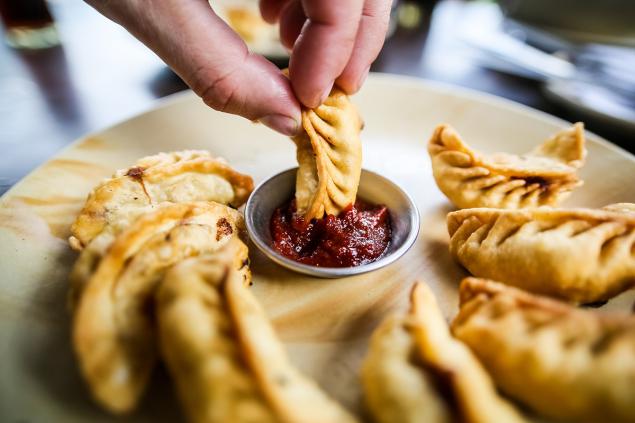
Thukpa
13. Another very popular dish is soup - thukpa and thentuk that differ form of noodles. In thukpu added long noodles, and thentuk - flat.

14. Thukpa meat. One such piece of substitutes at once and the first and second. The soup is very tasty, but the meat of yak - an amateur.
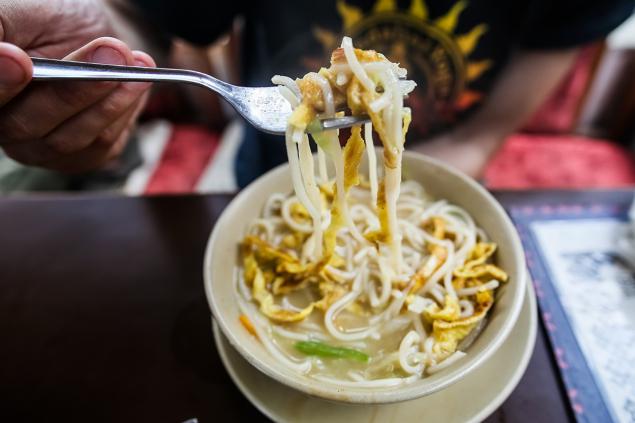
15. Thukpa with vegetables.
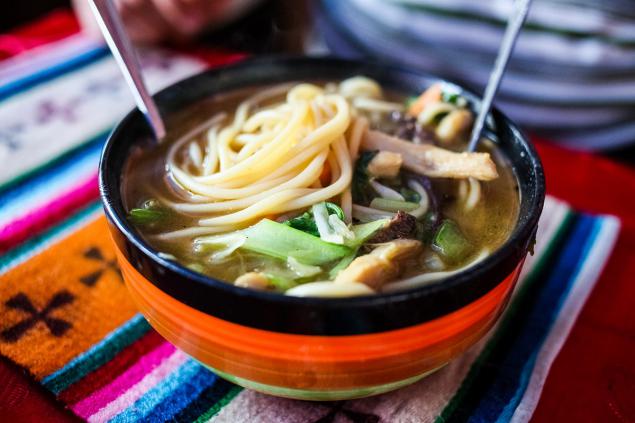
16. Thukpa of wide noodles.

17. Vegetable soup.
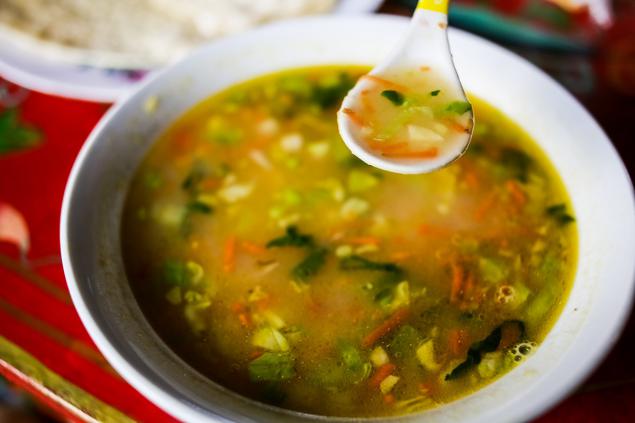
18. Chicken soup - oddly enough, the worst soup with a strange taste. I could not eat it one.

Bread
19. Tibetans bake their national bread, which, as in many Asian countries, in principle, similar to our pita bread. The only exception is the steam bread tingmo, which is likely to also come from the Chinese cuisine.

20. cakes with spicy sauce.

21. Steam fried bread. Steamed bread is very specific - for example, we could not eat it. The taste is reminiscent of soaked biscuits.

22.Pomimo momo and thukpy, you fed rice with meat or vegetables and noodles, which, again, has spread under the influence of China. Portions are usually very large, and even a man enough food.

23. Rice with vegetables. Figure in Tibet is excellent - and with vegetables and meat.
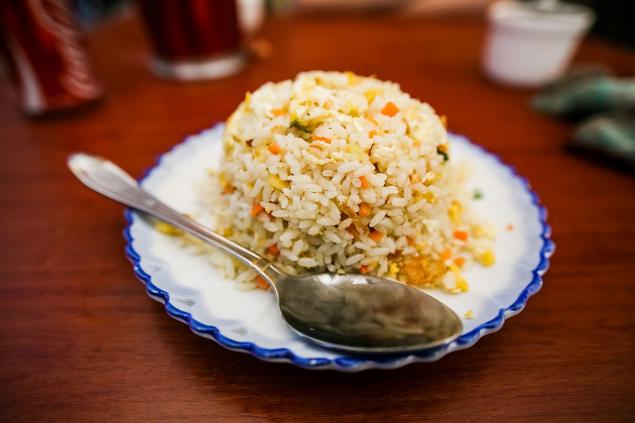
24. Rice with yak meat and vegetables.

25. Pasta with meat and vegetables.

26. Noodles with scrambled eggs and meat.

27. Roasted vegetables.
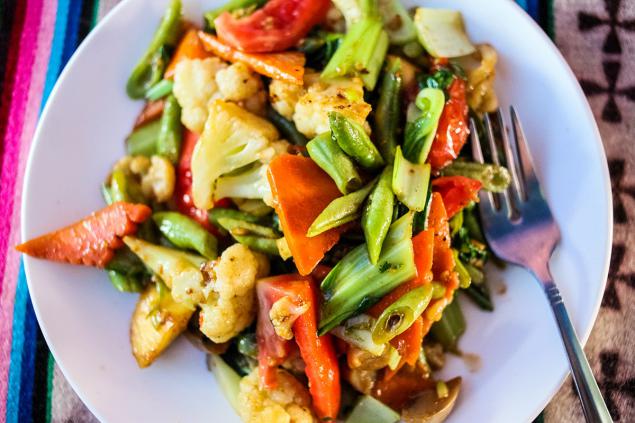
28. In some cafes near the border with Nepal can almost taste the European cuisine. For example, fried fish with fries.

29. Or fried potatoes. However, with a hot potato at the Tibetan problem, especially for those who live in the mountains. We could not explain what it is necessary to fry longer. We ate almost raw, but in those conditions and it was a delicacy.

30. In some monasteries have their own kitchen where you can for 40 rubles very tight lunch. The money is almost gone, and 40 rubles we got here is a delicious serving of rice and grilled vegetables - it was probably the most delicious our dinner.
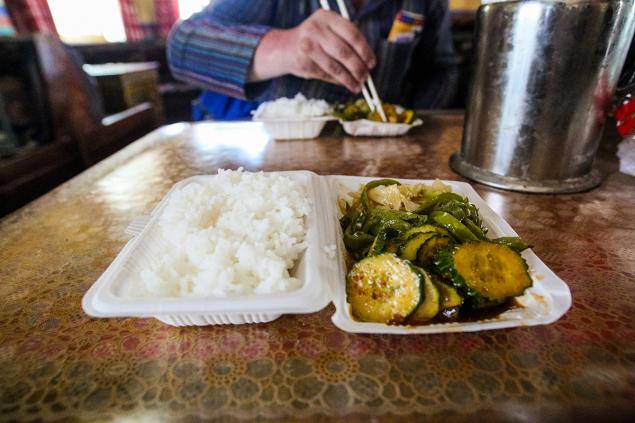
31.Chay
As for drinks, the most popular, of course, is tea. In Tibet, there are two unique kinds of tea. First - Ngam cha, foreigners Tibetans call it "suite ti" ("sweet tea"). It is a female yak boiled milk, butter, a little black tea and sugar. Very tasty and satisfying.
Second - cha suyma, also known as "butter tea", "salty tea", "tea shot down." It is prepared from the pressed Puer, which is cooked in milk and then whipped with melted yak butter and salt in a special wooden churn Donme. In our time, this is a traditional tool has replaced the electric whisk, which is available to any family, because the salty Tibetan tea drink in large quantities, and adults and children. Tibetans carry a thermos with drink everywhere: at work, in the field, for a walk. Any Tibetan gladly treat you with tea and milk. It warms and protected from penetrating Tibetan wind. Also ca suyma used for making tsampa.
The Tibetan restaurants can be found and other beverages, borrowed from India and China. For example, who came from Yunnan tea Woman ("Eight Treasures"). This traditional Chinese blend of eight types of flowers and dried fruit. You can also find popular in India and Nepal tea with ginger and lemon, but it will be quite expensive in these parts. Of course, civilization has penetrated even the most remote corners of the earth, and tea bags you can buy everywhere.
Ginger tea.

Chang
32. Probably the story of Tibetan cuisine would not be complete without a mention of Tibetan drinks selling chang, chang or ne. This barley wine, which in the West is often called the beer, distinctive taste and not very strong - only 3, 8%. In the shops you can buy in a blue or red jars, but restaurants have the opportunity to taste homemade chang. The traditions of its use are slightly different from region to region - for example, in Shigatse in a glass of Chang decided to add a little tsampa, which never do in Lhasa. But in any case, fans of Chung in Tibet very much. As for the real beer, here it is represented by only one local brand - "Lhasa". However, find popular European brands of beer here is not a problem.
Lunch cost varies depending on the location and availability of products. The average dinner costs 25-40 yuan. In big cities you can buy a large portion of French fries on the street for 5 yuan, or go to a local dining room measuring 10 square meters, and buy a huge portion of soup for 7-10 yuan.
Bon appetit and amazing trips!
Photo: Catherine Ageev / Text: Sergei Martynov

In Tibet, everything is unusual and usually at the same time. Harsh climatic conditions, high mountains, scorching sun, strong winds and sandy soil have a paramount influence on the cuisine, which is not particularly diverse.
32 photos via MOBBI

2. The basis of the diet of milk and meat of yak, or rather, in the case of milk - not yak and dri (yak lady is said to Tibetans), and barley flour. Sometimes also used goat meat and mutton. In any place, located above 4,000 meters above sea level, offers exclusively dishes from these products.

3. Typical Tibetan Cafe. It should be noted that the cafe is very dirty. In the highlands, where to go far to get water, you will give the general spoons and forks from the same bowl, and there is no certainty that they are washed. A little shocking at first, but then did not pay attention.
In the big cities, situated just below, at an altitude of approximately 3600-3800 meters above sea level, you can already taste the fruits and vegetables, most of which are imported to the Chinese.

4. Menu. We were lucky, as two of our company are studying the Tibetan language.

5. The most popular vegetables - a tomato and onion. Tomato soup can be enjoyed anywhere, but the texture and flavor are very different.

6. The soup is very tasty and is sometimes so thick that sounds more like a sauce to the meat. It happens a sharp, almost bland. This is probably the most delicious dish in Tibet.

7. And every morning in every cafe serves omelets. Where do I get an egg at an altitude of over 4,000 meters above sea level, remained a mystery for us. We did not see any chicken. Even soup with egg is actually a soup with sliced omelette. I think that they do it out of the dry mixture and especially for foreigners. Tibetans themselves every morning starts with tsampa ...

Zampa
8. Zampa - the most common dish. This is not a delicacy, and Tibetans eat it not a good life, but simply because there is often more than just nothing.

9. Zampa is a mixture of milk dri (female yak) butter and barley flour. Barley, in accordance with Tibetan medicine, good product to impart strength. In barley a lot of iron, and his frequent use eliminates the traditional problems with anemia associated with poor nutrition in the mountains. In addition, good barley eliminates swelling, often emerging from the monks of the sedentary lifestyle and sitting too long in one position. Iron also has a good effect on the lungs and bronchi, which often have problems from the mountain wind and cold.
By itself, barley (ie, if you eat it as porridge and cooked barley usual) is considered to be "cold" in its properties. If you roast and grind the barley, then its properties will change to warming. This is very useful for dealing with meditation, since they are often the heat accumulated in the head and below the heart - solid cold and problems with internal organs. They say that Yogi kidney infection - so to speak occupational disease.

10. Every morning, in any cafe or dining room guesthouse you can treat tsampa. The taste resembles milled oatmeal, which is given to babies years old. We were treated to a free tsampa, is the cheapest dish. You are served a large bowl of flour, a thermos with salty Tibetan tea, sugar and oil, and you will in its sole discretion mix the ingredients - someone who likes to liquid, some thick tsampa. Tibetans usually make very thick and eat tsampa her hands.

Momo
11. The second most popular national dish - is momo dumplings. If there is a single dish, which can be represented Tibetan cuisine, then this is it. Momo - it's dumplings, steamed and served them on any weekday and holidays. There is only one exception - momo never eat on the first day of the new year, because the meat is left to the dough, means to hide luck.

12. Preparation Momo takes a lot of time, so they are working on several people. Men usually chopped meat, and women shape the dumplings. All the subtleties of cooking techniques aimed at preserving momo juices inside. Therefore, the meat is better to cut than to grind, and vegetables should be handled very carefully. Moreover, Momo can not digest.
Also, there are some nuances and eating momos. First you have to bite off a piece of dough and drink juice, then scoop up the sauce and eat the rest. Momo delicious in any form.

Thukpa
13. Another very popular dish is soup - thukpa and thentuk that differ form of noodles. In thukpu added long noodles, and thentuk - flat.

14. Thukpa meat. One such piece of substitutes at once and the first and second. The soup is very tasty, but the meat of yak - an amateur.

15. Thukpa with vegetables.

16. Thukpa of wide noodles.

17. Vegetable soup.

18. Chicken soup - oddly enough, the worst soup with a strange taste. I could not eat it one.

Bread
19. Tibetans bake their national bread, which, as in many Asian countries, in principle, similar to our pita bread. The only exception is the steam bread tingmo, which is likely to also come from the Chinese cuisine.

20. cakes with spicy sauce.

21. Steam fried bread. Steamed bread is very specific - for example, we could not eat it. The taste is reminiscent of soaked biscuits.

22.Pomimo momo and thukpy, you fed rice with meat or vegetables and noodles, which, again, has spread under the influence of China. Portions are usually very large, and even a man enough food.

23. Rice with vegetables. Figure in Tibet is excellent - and with vegetables and meat.

24. Rice with yak meat and vegetables.

25. Pasta with meat and vegetables.

26. Noodles with scrambled eggs and meat.

27. Roasted vegetables.

28. In some cafes near the border with Nepal can almost taste the European cuisine. For example, fried fish with fries.

29. Or fried potatoes. However, with a hot potato at the Tibetan problem, especially for those who live in the mountains. We could not explain what it is necessary to fry longer. We ate almost raw, but in those conditions and it was a delicacy.

30. In some monasteries have their own kitchen where you can for 40 rubles very tight lunch. The money is almost gone, and 40 rubles we got here is a delicious serving of rice and grilled vegetables - it was probably the most delicious our dinner.

31.Chay
As for drinks, the most popular, of course, is tea. In Tibet, there are two unique kinds of tea. First - Ngam cha, foreigners Tibetans call it "suite ti" ("sweet tea"). It is a female yak boiled milk, butter, a little black tea and sugar. Very tasty and satisfying.
Second - cha suyma, also known as "butter tea", "salty tea", "tea shot down." It is prepared from the pressed Puer, which is cooked in milk and then whipped with melted yak butter and salt in a special wooden churn Donme. In our time, this is a traditional tool has replaced the electric whisk, which is available to any family, because the salty Tibetan tea drink in large quantities, and adults and children. Tibetans carry a thermos with drink everywhere: at work, in the field, for a walk. Any Tibetan gladly treat you with tea and milk. It warms and protected from penetrating Tibetan wind. Also ca suyma used for making tsampa.
The Tibetan restaurants can be found and other beverages, borrowed from India and China. For example, who came from Yunnan tea Woman ("Eight Treasures"). This traditional Chinese blend of eight types of flowers and dried fruit. You can also find popular in India and Nepal tea with ginger and lemon, but it will be quite expensive in these parts. Of course, civilization has penetrated even the most remote corners of the earth, and tea bags you can buy everywhere.
Ginger tea.

Chang
32. Probably the story of Tibetan cuisine would not be complete without a mention of Tibetan drinks selling chang, chang or ne. This barley wine, which in the West is often called the beer, distinctive taste and not very strong - only 3, 8%. In the shops you can buy in a blue or red jars, but restaurants have the opportunity to taste homemade chang. The traditions of its use are slightly different from region to region - for example, in Shigatse in a glass of Chang decided to add a little tsampa, which never do in Lhasa. But in any case, fans of Chung in Tibet very much. As for the real beer, here it is represented by only one local brand - "Lhasa". However, find popular European brands of beer here is not a problem.
Lunch cost varies depending on the location and availability of products. The average dinner costs 25-40 yuan. In big cities you can buy a large portion of French fries on the street for 5 yuan, or go to a local dining room measuring 10 square meters, and buy a huge portion of soup for 7-10 yuan.
Bon appetit and amazing trips!
Photo: Catherine Ageev / Text: Sergei Martynov


